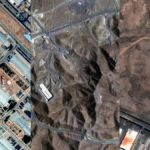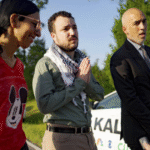A 40-year-old man died while canyoneering in Heaps Canyon at Zion National Park in Utah. This happened on October 5, 2024. He fell about 150 to 200 feet while exploring with a group of three others.
The incident happened around 6 PM, as the group followed an approved plan. Despite rescue efforts from many agencies, the man was pronounced dead at the scene. He couldn’t be taken to a hospital in time.
Over 50 rescuers worked hard to get the other canyoneers out of Heaps Canyon. Two were rescued the next morning. The third was helped by the team to rappel down safely.
Key Takeaways
- A 40-year-old man tragically died after a 150-200 foot fall while canyoneering in Heaps Canyon, Zion National Park.
- The incident occurred with a group of three other canyoneers, and more than 50 rescuers were involved in the response.
- Heaps Canyon is known for being a strenuous, challenging, and technical canyon with a 3,000-foot descent, usually requiring 12-20 hours to complete.
- This incident marks the third death in Heaps Canyon in recent years, with previous fatalities recorded in 2015 and 2021.
- The park and sheriff’s office are investigating the incident to determine the exact cause and circumstances surrounding the accident.
Tragic Canyoneering Accident in Zion National Park
On October 5, 2024, a tragic canyoneering accident happened in Heaps Canyon, Zion National Park. A 40-year-old man lost his life. The incident occurred around 6 PM when a group of four canyoneers faced a fatal mishap while navigating the technical terrain.
Details of the Incident
The victim, Andrew Arvig, fell 150 to 200 feet while canyoneering. His companions were with him. Despite quick help from the Zion National Park Technical Search and Rescue Team and the Washington County Sheriff’s Office, Arvig died before he could get to a hospital.
Rescue Efforts and Response
More than 50 people helped in the rescue. Teams from the Springdale Police Department, Hurricane Valley Fire and Rescue, the Washington County Sheriff’s Office, and Intermountain Life Flight were involved. Two of the three other canyoneers were pulled out safely the next morning. The third was helped by the search and rescue team to rappel down.
The accident in Heaps Canyon highlights the dangers of technical canyoneering in Zion National Park. Authorities are still looking into what caused the accident. The canyoneering community is reminded to always follow the best technical skills, gear, and safety practices when exploring Utah’s wilderness and technical canyons.
Canyoneering in Zion National Park

The Challenge of Heaps Canyon
Zion National Park is a top spot for canyoneering fans. It has tough terrain and narrow slot canyons that test adventurers. Heaps Canyon is one such place, known for its dangers.
The National Park Service calls Heaps Canyon a tough canyon. It’s a 3,000-foot drop that takes 12 to 20 hours to finish. You’ll face many rappels into cold water and a final 280-foot rappel to the Upper Emerald Pool area.
Heaps Canyon needs special skills and gear for canyoneers. The park rates canyons from one to five stars. The highest rappel can be 15 to 300 feet, offering different experiences.
| Canyoneering Tour Type | Number of Rappels | Price Range (per person) | Duration |
|---|---|---|---|
| Half-day Canyoneering Tour | 2 – 6 rappels | $144.27 – $410.22 | 3.5 – 4 hours |
| Full-day Canyoneering Tour | 4 – 12 rappels | $162.45 – $682.64 | 6.5 – 7.5 hours |
Completing a canyon in Zion can take from 1-2 hours to 1.5 days. The park has routes for all skill levels, from 3A to 4B.
Canyoneering in Zion is thrilling and beautiful. But, it’s also risky. Canyoneers must be careful, skilled, and well-equipped to stay safe.
Safety Precautions for Canyoneering

Canyoneering in Zion National Park and other wilderness areas needs careful planning and strict safety rules. You must have the right gear, like a secure harness, helmet, and canyoneering equipment. It’s also important to know how to use ropes, navigate, and handle emergencies.
Before you start, pick a safe route, check the weather, and have a rescue plan ready. Know your limits and the dangers of the terrain, like tight spots, cold water, and flash floods.
- Wear a helmet to prevent serious head injuries, which are common in canyoneering accidents.
- Invest in a harness, rappel device, and other specialized canyoneering gear to ensure safety during descents and ascents.
- Acquire technical skills through training courses or learning from experienced canyoneers to navigate the challenges of the canyon.
- Travel in a group of at least two people for all technical canyons that involve the use of rope, webbing, or other descent or ascent devices.
- Be prepared for the unique conditions of the Colorado Plateau canyons, including the risk of hypothermia and heat-related illnesses.
By focusing on safety and being well-prepared, you can enjoy the thrill of exploring Zion’s slot canyons without risks.
“Canyoneering is a high-risk sport that requires participants to have trusty and knowledgeable guides for safety. Proper training and equipment are essential to ensure a safe and enjoyable experience.”
Previous Canyoneering Accidents in Zion

Zion National Park has seen many fatal canyoneering accidents. These incidents show the dangers of this exciting yet challenging activity. They remind us of the need for careful planning, proper training, and strict safety rules.
2015 Incident in Heaps Canyon
In 2015, a 24-year-old canyoneer died after falling in Heaps Canyon. He was with a group of four trying to cross the difficult terrain. The accident was a tragic reminder of the risks.
2021 Fatality in the Same Canyon
In 2021, another canyoneer, a 31-year-old man, died in Heaps Canyon. He missed a rock ledge while rappelling and got stuck 260 feet up. His death shows how dangerous this sport can be.
The accidents in Heaps Canyon and other canyons in Zion are a wake-up call. They show the risks of canyoneering. They remind us of the need for training, the right gear, and understanding the dangers.
Also Read : Former New York Gov. Paterson And His Stepson Attacked During A Walk In Manhattan.
Conclusion
The tragic canyoneering accident in Zion National Park’s Heaps Canyon is a harsh reminder of the dangers in this sport. Canyoneering is thrilling but comes with big risks. It needs careful planning, special skills, and strict safety rules.
The National Park Service and local authorities are looking into the accident. Their findings could help make canyoneering safer and prevent more tragedies.
This accident shows how crucial it is to plan well, use the right gear, and respect nature’s power. Experienced canyoneers and guides are key. They make smart choices, navigate technical canyons, and keep everyone safe on a canyoneering trip.
If you want to try canyoning in Zion National Park and the Colorado Plateau, get help from trusted outfitters. Learn the necessary technical skills and know the canyon safety and gear rules. With careful preparation, caution, and respect for nature, you can enjoy the beauty and challenges of canyoneering safely.
FAQs
Q: What should I know before going canyoneering in Utah?
A: Before going canyoneering in Utah, it’s important to understand the technical skills required for the activity, such as rope work and anchor setup. Make sure to choose the right canyoneering route that matches your skill level, whether you’re a beginner or more experienced. Additionally, familiarize yourself with the area, including potential hazards like potholes and the need for proper footwear and gear.
Q: Are there guided canyoneering tours available in Moab?
A: Yes, there are numerous guided canyoneering tours available in Moab. Hiring a canyoneering guide can enhance your experience, especially if you are new to canyoneering in Utah. A guide will provide you with the necessary technical gear, instruction, and ensure your safety throughout the trip.
Q: What types of canyoneering routes can I find in southern Utah?
A: Southern Utah features a variety of canyoneering routes, ranging from beginner-friendly hikes to more advanced technical climbs. Popular areas include North Wash, Robbers Roost, and the Black Hole. Each route offers unique scenic views, such as sandstone formations and the iconic Morning Glory Arch.
Q: Is canyoneering in Utah safe for beginners?
A: Canyoneering can be safe for beginners if they take proper precautions, such as participating in guided tours and using appropriate technical gear. Beginners should start with easier routes and gradually build their skills. It’s also essential to be aware of the risks involved, such as falls and injuries, and to carry a first aid kit.
Q: What kind of technical gear is needed for a canyoneering adventure?
A: Essential technical gear for a canyoneering adventure includes a harness, rope, helmet, and rappel device. Depending on the route, you may also need additional equipment like carabiners, webbing for anchors, and possibly a wetsuit for wet canyons. Always consult with your canyoneering guide to ensure you have the right gear.
Q: How do I prepare for a full day of canyoneering in Utah?
A: Preparing for a full day of canyoneering in Utah involves multiple steps. First, choose a suitable canyoneering route that matches your skill level. Pack adequate food and water, wear appropriate footwear, and bring a backpack for your gear. It’s also wise to check weather conditions and inform someone about your hiking plan.
Q: What are the environmental considerations while canyoneering?
A: When canyoneering, it’s important to practice minimum impact principles to preserve the natural environment. Stick to established trails, avoid disturbing wildlife, and pack out all trash. Be mindful of sensitive areas, such as delicate potholes, and follow guidelines to prevent erosion of the scenic sandstone formations.
Q: What should I do if I get stuck in a pothole during canyoneering?
A: If you find yourself stuck in a pothole during canyoneering, remain calm and assess the situation. Look for ways to climb out or use your rope work skills to escape. If you are unable to get out safely, signal for help, especially if you are with a group. Carrying a first aid kit is also advisable in case of emergencies.
Q: Where can I find the best canyoneering guides in Moab?
A: The best canyoneering guides in Moab can typically be found through local outfitters and adventure companies. Research online reviews and ask for recommendations to find great guides who can provide a safe and enjoyable canyoneering experience. Many guides offer tailored trips that range in difficulty and duration.
Source Links
- https://www.nbcnews.com/news/us-news/man-falls-death-canyoneering-utah-zion-national-park-rcna174206
- https://www.aol.com/news/man-falls-death-while-canyoneering-010303321.html
- https://people.com/human-interest/man-canyoneering-dies-in-zion-national-park-after-dangling-from-rope-overnight/
- https://climb-utah.com/Zion/kolob1.htm
- https://www.climbing.com/news/one-dead-two-rescued-after-rappelling-accident-in-zion/




